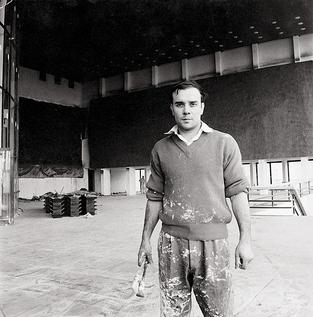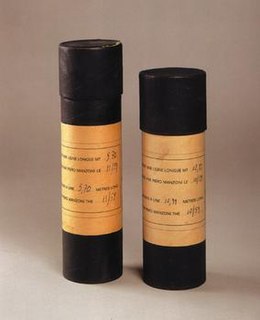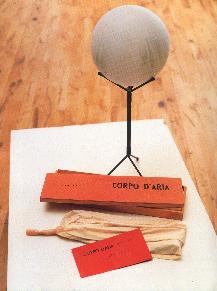
Yves Klein was a French artist and an important figure in post-war European art. He was a leading member of the French artistic movement of Nouveau réalisme founded in 1960 by art critic Pierre Restany. Klein was a pioneer in the development of performance art, and is seen as an inspiration to and as a forerunner of minimal art, as well as pop art.

Piero Manzoni di Chiosca e Poggiolo, better known as Piero Manzoni was an Italian artist best known for his ironic approach to avant-garde art. Often compared to the work of Yves Klein, his own work anticipated, and directly influenced, the work of a generation of younger Italian artists brought together by the critic Germano Celant in the first Arte Povera exhibition held in Genoa, 1967. Manzoni is most famous for a series of artworks that call into question the nature of the art object, directly prefiguring Conceptual Art. His work eschews normal artist's materials, instead using everything from rabbit fur to human excrement in order to "tap mythological sources and to realize authentic and universal values".

Arte Povera was an art movement that took place between the end of the 1960s and the beginning of the 1970s in major cities throughout Italy and above all in Turin. Other cities where the movement was also important are Milan, Rome, Genoa, Venice, Naples and Bologna. The term was coined by Italian art critic Germano Celant in 1967 and introduced in Italy during the period of upheaval at the end of the 1960s, when artists were taking a radical stance. Artists began attacking the values of established institutions of government, industry, and culture.
Events from the year 1960 in art.
Germano Celant was an Italian art historian, critic and curator who coined the term "Arte Povera" in 1967 and wrote many articles and books on the subject.

Alberto Burri was an Italian visual artist, painter, sculptor and physician based in Città di Castello. He is associated with the matterism of the European informal art movement and described his style as a polymaterialist. He had connections with Lucio Fontana's spatialism and, with Antoni Tàpies, an influence on the revival of the art of post-war assembly in America as in Europe.

Flash Art is a contemporary art magazine, and an Italian and international publishing house. Originally published bilingually, both in Italian and in English, since 1978 is published in two separate editions, Flash Art Italia (Italian) and Flash Art International (English). Since September 2020, the magazine is seasonal, and said editions are published four times a year.

Artist's Shit is a 1961 artwork by the Italian artist Piero Manzoni. The work consists of 90 tin cans, each reportedly filled with 30 grams (1.1 oz) of faeces, and measuring 4.8 by 6.5 centimetres, with a label in Italian, English, French, and German stating:
Artist's Shit
Contents 30 gr net
Freshly preserved
Produced and tinned
in May 1961
Luciano Fabro was an Italian sculptor, conceptual artist and writer associated with the Arte Povera movement.

Michael Bidlo is an American conceptual artist who employs painting, sculpture, drawing, performance, and other forms of "social sculpture."

Linee (lines) is an artist's book by the Italian artist Piero Manzoni, created in 1959. Each work consists of a cardboard tube, a scroll of paper with a black line drawn down it, and a simple printed and autographed label. This label contains a brief description of the work, the work’s length, the artist’s name and the date it was created. Most of the lines were made between September and December 1959. 68 are known to have been made, each with different length strips inside.

Zone de Sensibilité Picturale Immatérielle is an artist's book and performance by the French artist Yves Klein. The work involved the sale of documentation of ownership of empty space, taking the form of a receipt, in exchange for gold; if the buyer wished, the piece could then be completed in an elaborate ritual in which the buyer would burn the receipt, and Klein would throw half of the gold into the Seine. The ritual would be performed in the presence of an art critic or distinguished dealer, an art museum director and at least two witnesses.

Italian Contemporary art refers to painting and sculpture in Italy from the early 20th century onwards.
Marisa Merz was an Italian artist and sculptor. In the 1960s, Merz was the only female protagonist associated with the radical Arte povera movement. In 2013 she was awarded the Golden Lion for Lifetime Achievement at the Venice Biennale. She lived and worked in Turin, Italy.
Giulio Paolini is an Italian artist associated with both Arte Povera and Conceptual Art.

Nuclear art was an artistic approach developed by some artists and painters, after the bombings of Hiroshima and Nagasaki.

Gilberto Zorio is an Italian artist associated with the Italian Arte Povera movement. Zorio's artwork shows his fascination with natural processes, alchemical transformation, and the release of energy. His sculptures, paintings, and performances are often read as metaphors for revolutionary human action, transformation, and creativity. He is known for his use of materials including: incandescent electric light tubes, steel, pitch, motifs, and processes through the use of evaporation and oxidation. He also creates precarious installations using fragile materials such as Stella di Bronzo and Acidi within his work.
For the 19th-century painter and sculptor, see Pier Celestino Gilardi
Ettore Sordini was an Italian artist, a disciple of Lucio Fontana, a friend and collaborator of Piero Manzoni and a member of the Gruppo del Cenobio.

Eduarda Emilia Maino, known as Dadamaino, was an Italian visual artist and painter. She was a member of the Milanese avant-garde of the 1960s.













